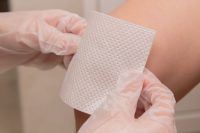
Skin biopsies can look scary, as depending on how deep the biopsy needs to be, they can leave a wound of varying depths and sizes. Dr. Tanya Sale has tips for wound care following biopsy to help your skin heal faster and leave fewer scars.
Clean the Area
The dermatologist conducting the biopsy will begin the process of wound care for you, starting with cleaning the area. Any time your skin is broken or otherwise injured and the wound is simple enough to treat yourself, you should always make sure the wound and surrounding area are clean to prevent infection. In some cases of simple wounds, soap and water may be enough. If the wound is so deep that cleaning it is difficult, or if it is an bad burn, see a doctor.
Apply Vaseline for Wound Care
To create a barrier against more contamination or germs, Dr. Sale recommends applying Vaseline. While Vaseline doesn’t seal the wound, it does offer protection with its jelly-like consistency that is difficult to penetrate and stimulates healing.
Use a Pressure Bandage
Once cleaned and covered in Vaseline the dermatologist will apply a pressure bandage. Pressure bandages help control bleeding, prevent infection or further damage and are a vital part of a wound care routine. They should be applied tightly but not too tightly, or they’ll affect circulation. This article explains pressure bandages and how to use them. Again, for an injury you sustain outside of a biopsy situation where bandaging is required, consult your doctor.
Continued Wound Care
Typically the next day after your biopsy you can remove the bandage before showering and lather the wound with soap and water for 30 seconds. Once out of the shower, pat the wound dry and re-apply Vaseline. Finish by putting on a fresh, clean, dry bandage.
If you don’t have Vaseline you can use Aquaphor or Neosporin ointment. All of these ointments have a greasy quality that protects wounds, keeps skin moisturized and encourages quick healing by letting new skin cells grow and repair more easily. Do this once every day until the wound is healed over.
Some Scarring May Occur
Even with this effective regimen some areas of the body are prone to specific types of scarring like keloids. If you develop scars that are itchy, ugly or painful, see your dermatologist. We have in-office treatments available to minimize such scarring.
Learn more from Dr. Sale: